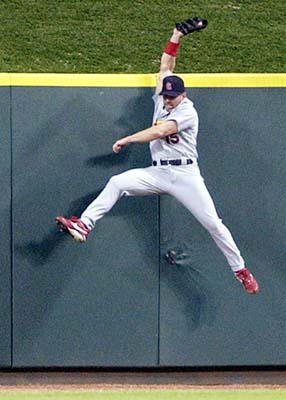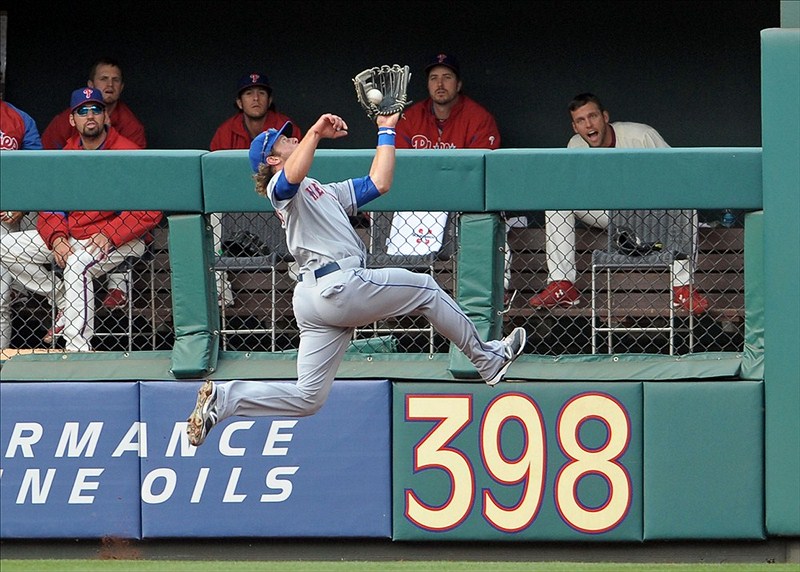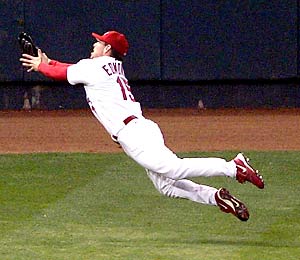Thoughts from Joe D. – I wanted to revisit this post Pete wrote a week ago because I believe the conversation has gained some relevancy now. Since the day Pete made the comparison to Jim Edmonds, I’m seeing that defensive comparison popping up in many circles in the last 48 hours.
What Pete said about not needing to have speed as a primary attribute to play a great center field, has been on full display in the dynamic outfield play exhibited by Kirk Nieuwenhuis.
Kirk will never invoke memories of Carlos Beltran effortlessly gliding to balls that most center fielders don’t get to, but I do see that reckless abandon style that was such a big part of Jim Edmonds’ game. He runs great routes, gets some amazing jumps, and uses his body in an all-out attempt to get to the ball and make the play. I haven’t seen such exciting play in center field in some time.
Now if only Nieuwenhuis can end up evolving into the hitter that Edmonds was….
Still to early for that kind of talk, but time will tell….
Original Post 4/15
The big question regarding Kirk Nieuwenhuis is, “Is he the Mets center-fielder of the future?” The skeptics would say no, that he doesn’t possess the pure blazing speed required to play the position in the major leagues. But is it necessary to be a “burner” to play CF effectively?
Although having plus speed definitely helps to make up for mistakes, it is not a requirement to play center. The key is to limit your mistakes, and a smart player like Captain Kirk can do that. By doing three things consistently on defense, an outfielder can be successful playing center field, regardless of speed.
1st) Positioning. The player must work in conjunction with his outfield coach, and the game-plan of the pitcher and catcher in attacking each hitter, to see that he is positioned in the highest percentage spot to defend.
2nd) Reaction Time. What kind of jumps does the outfielder typically get when the ball first leaves the bat. The quicker the player reacts, and the better he is at instinctively moving in the right direction with his first step, the more effective he will be at tracking fly balls.
3rd) Routes taken to the ball. This is set up initially by number “two,” where the player takes that instinctive first step. Then his skill at geometry and tracking a ball in flight takes over as he selects the best and shortest route to where he determines the ball is going to come down. This selection process takes less than half-a-second, and can be improved through practice and experience.
There are startling similarities between the Captain, and an 8-time Gold Glove Award winner in CF, by the name of Jim Edmonds. First, they are both left-handed hitters with considerable pop. Second, they both strike (struck) out a lot. Edmonds is listed at 6’1″, 190 lbs. Kirk at 6’3″ 215 lbs. Neither player is (or was) considered very fast, but despite this Edmonds played until he was 40, and was effective in CF until he was 37.
winner in CF, by the name of Jim Edmonds. First, they are both left-handed hitters with considerable pop. Second, they both strike (struck) out a lot. Edmonds is listed at 6’1″, 190 lbs. Kirk at 6’3″ 215 lbs. Neither player is (or was) considered very fast, but despite this Edmonds played until he was 40, and was effective in CF until he was 37.
I don’t know about you, but if Captain Kirk can master the CF position in much the same way that Jim Edmonds did for so many years, I would sign up for that right now. I know the Mets are looking at Nimmo, and den Dekker, and Ceciliani, and even Valdespin as possible center fielders of the future for the Mets, but the real future in CF may be now.

















